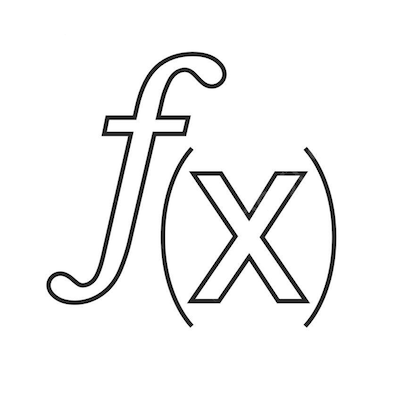Announcements & Reminders
Results of Online test 2
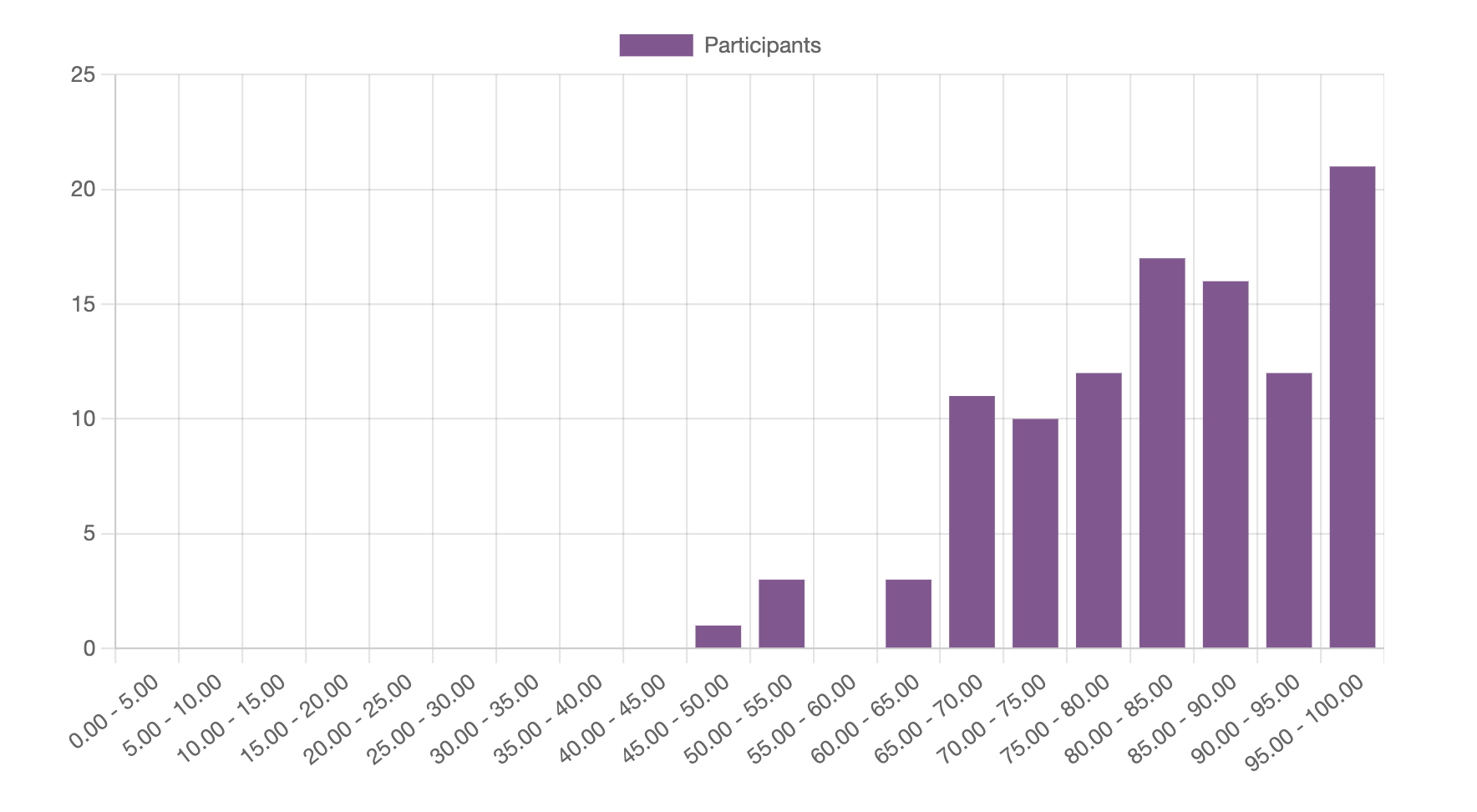
Fig. 23 Distribution of results for Online test 2#
Teaching break: next two weeks April 1st to 14th
No teaching
No tutorials
Next lecture is on April 16th
Next online test is on April 22nd, after the next lecture
Have a good break!
📖 Univariate differentiation#
⏱ | words
Sources and reading guide#
Sources and reading guide
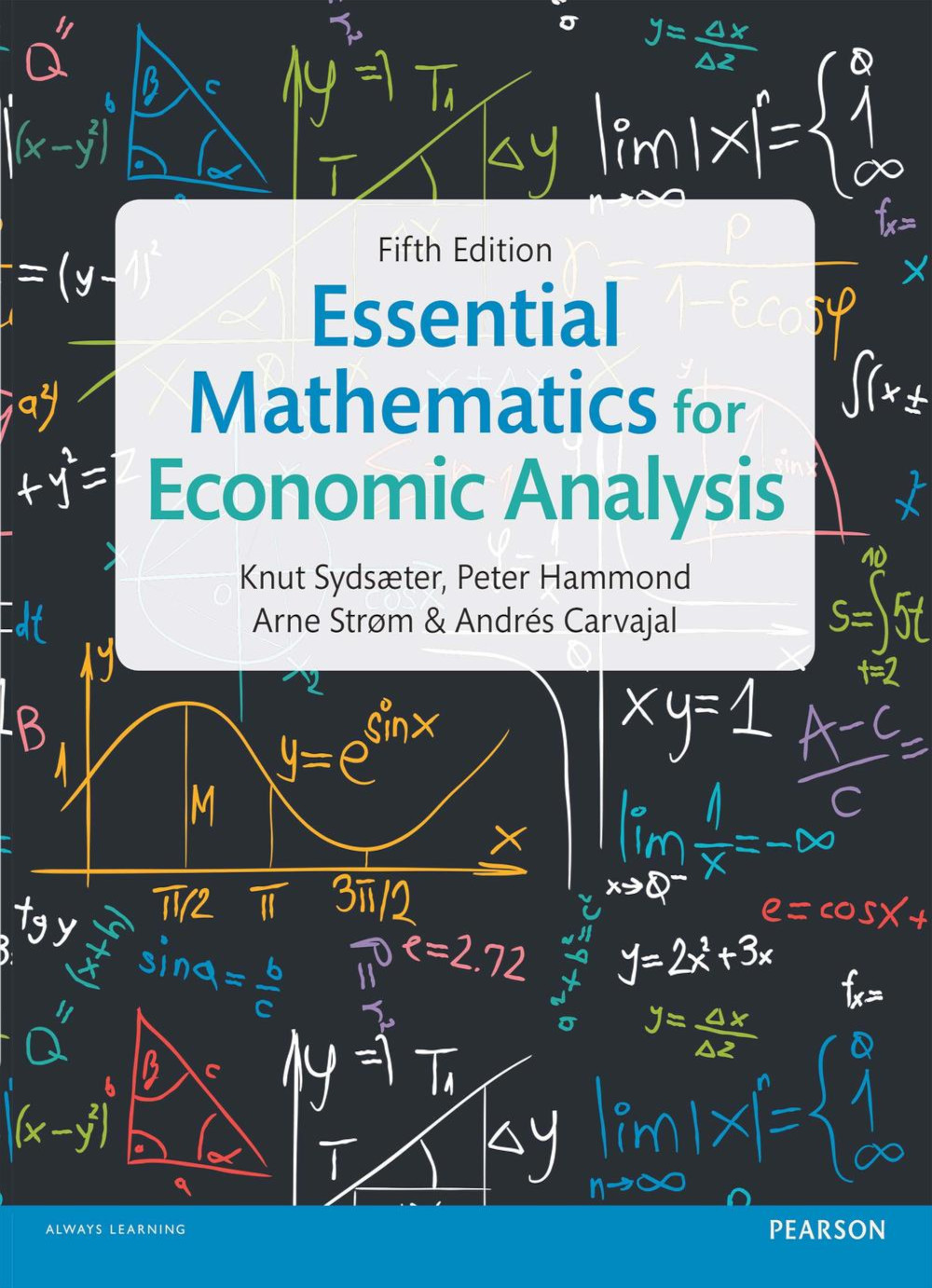
[Sydsæter, Hammond, Strøm, and Carvajal, 2016]
Chapters 6, 7, and 8.
Introductory level references:
[Bradley, 2008]: Chapter 6 (pp. 257–357).
[Haeussler Jr and Paul, 1987]: Chapters 10, 11, 12, and 13 (pp. 375–532).
[Shannon, 1995]: Chapter 8 (pp. 356–407).
More advanced references:
[Chiang and Wainwright, 2005]: Chapters 6–10 (pp. 124–290).
[Kline, 1967]: Chapters 2, 4, 5, 6, 7, 12, 13, and 20.
[Silverman, 1969]: Chapters 4, 5, and 6.
[Simon and Blume, 1994]: Chapters 2–5 (pp. 10–103).
[Spivak, 2006]: Chapters 3–12 (pp. 39–249).
Limit for functions#
Consider a univariate function \(f: \mathbb{R} \rightarrow \mathbb{R}\) written as \(f(x)\)
The domain of \(f\) is \(\mathbb{R}\), the range of \(f\) is a (possibly improper) subset of \(\mathbb{R}\)
[Spivak, 2006] (p. 90) provides the following informal definition of a limit: “The function \(f\) approaches the limit \(l\) near [the point \(x =\)] \(a\), if we can make \(f(x)\) as close as we like to \(l\) by requiring that \(x\) be sufficiently close to, but unequal to, \(a\).”
Definition
The function \(f: \mathbb{R} \rightarrow \mathbb{R}\) approaches the limit \(l\) near [the point \(x = a\)] if for every \(\epsilon > 0\), there is some \(\delta > 0\) such that, for all \(x\) such as \(0 < |x − a| < \delta\), \(|f(x) − l | < \epsilon\).
The absolute value \(|\cdot|\) in this definition plays the role of general distance function \(\|\cdot\|\) which would be appropriate for the functions from \(\mathbb{R}^n\) to \(\mathbb{R}^k\). We will also use \(d(x,a)\) to denote distance, i.e. \(d(x,a) = |x-a|\).
Suppose that the limit of \(f\) as \(x\) approaches \(a\) is \(l\). We can write this as
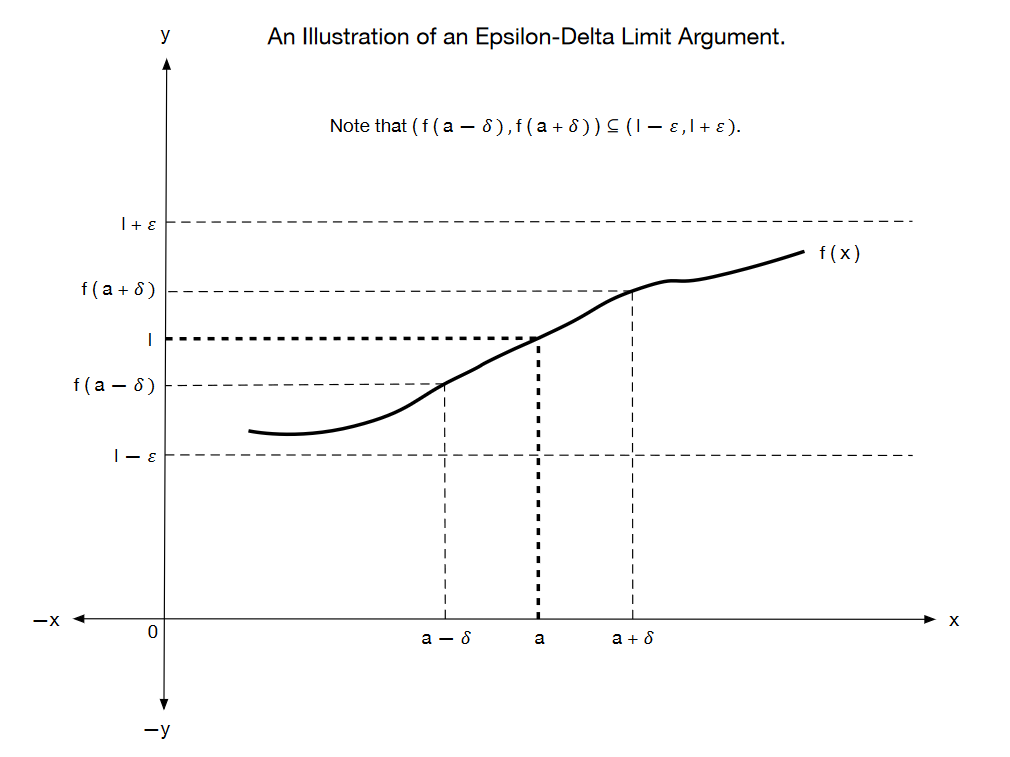
Fig. 24 An illustration of an epsilon-delta limit argument#
The structure of \(\epsilon–\delta\) arguments#
Suppose that we want to attempt to show that \(\lim _{x \rightarrow a} f(x)=b\).
In order to do this, we need to show that, for any choice \(\epsilon>0\), there exists some \(\delta_{\epsilon}>0\) such that, whenever \(|x-a|<\delta_{\epsilon}\), it is the case that \(|f(x)-b|<\epsilon\).
We write \(\delta_{\epsilon}\) to indicate that the choice of \(\delta\) is allowed to vary with the choice of \(\epsilon\).
An often fruitful approach to the construction of a formal \(\epsilon\)-\(\delta\) limit argument is to proceed as follows:
Start with the end-point that we need to establish: \(|f(x)-b|<\epsilon\).
Use appropriate algebraic rules to rearrange this “final” inequality into something of the form \(|k(x)(x-a)|<\epsilon\).
This new version of the required inequality can be rewritten as \(|k(x)||(x-a)|<\epsilon\).
If \(k(x)=k\), a constant that does not vary with \(x\), then this inequality becomes \(|k||x-a|<\epsilon\). In such cases, we must have \(|x-a|<\frac{\epsilon}{|k|}\), so that an appropriate choice of \(\delta_{\epsilon}\) is \(\delta_{\epsilon}=\frac{\epsilon}{|k|}\).
If \(k(x)\) does vary with \(x\), then we have to work a little bit harder.
Suppose that \(k(x)\) does vary with \(x\). How might we proceed in that case? One possibility is to see if we can find a restriction on the range of values for \(\delta\) that we consider that will allow us to place an upper bound on the value taken by \(|k(x)|\).
In other words, we try and find some restriction on \(\delta\) that will ensure that \(|k(x)|<K\) for some finite \(K>0\). The type of restriction on the values of \(\delta\) that you choose would ideally look something like \(\delta<D\), for some fixed real number \(D>0\). (The reason for this is that it is typically small deviations of \(x\) from a that will cause us problems rather than large deviations of \(x\) from a.)
If \(0<|k(x)|<K\) whenever \(0<\delta<D\), then we have
In such cases, an appropriate choice of \(\delta_{\epsilon}\) is \(\delta_{\epsilon}=\min \left\{\frac{\epsilon}{K}, D\right\}\).
Heine and Cauchy definitions of the limit for functions#
As a side note, let’s mention that there are two ways to define the limit of a function \(f\).
The above \(\epsilon\)-\(\delta\) definition is is due to Augustin-Louis Cauchy.
The limit for functions can also be defined through the limit of sequences we were talking about in the last lecture. This equivalent definition is due to Eduard Heine
Definition (Limit of a function due to Heine)
Given the function \(f: A \subset \mathbb{R} \to \mathbb{R}\), \(a \in \mathbb{R}\) is a limit of \(f(x)\) as \(x \to x_0 \in A\) if
note the crucial requirement that \(f(x_n) \to a\) has to hold for all converging to \(x_0\) sequences \(\{x_n\}\) in \(A\)
note also how the Cauchy definition is similar to the definition of a limit to a sequence
Fact
Cauchy and Heine definitions of the function limit are equivalent
Therefore we can use the same notation of the definition of the limit of a function
Some useful rules about limits#
In practice, we would like to be able to find at least some limits without having to resort to the formal “epsilon-delta” arguments that define them. The following rules can sometimes assist us with this.
Fact
Let \(c \in \mathbb{R}\) be a fixed constant, \(a \in \mathbb{R}, \alpha \in \mathbb{R}, \beta \in \mathbb{R}, n \in \mathbb{N}\), \(f: \mathbb{R} \longrightarrow \mathbb{R}\) be a function for which \(\lim _{x \rightarrow a} f(x)=\alpha\), and \(g: \mathbb{R} \longrightarrow \mathbb{R}\) be a function for which \(\lim _{x \rightarrow a} g(x)=\beta\). The following rules apply for limits:
\(\lim _{x \rightarrow a} c=c\) for any \(a \in \mathbb{R}\).
\(\lim _{x \rightarrow a}(c f(x))=c\left(\lim _{x \rightarrow a} f(x)\right)=c \alpha\).
\(\lim _{x \rightarrow a}(f(x)+g(x))=\left(\lim _{x \rightarrow a} f(x)\right)+\left(\lim _{x \rightarrow a} g(x)\right)=\alpha+\beta\).
\(\lim _{x \rightarrow a}(f(x) g(x))=\left(\lim _{x \rightarrow a} f(x)\right)\left(\lim _{x \rightarrow a} g(x)\right)=\alpha \beta\).
\(\lim _{x \rightarrow a}\left(\frac{f(x)}{g(x)}\right)=\frac{\lim _{x \rightarrow a} f(x)}{\lim _{x \rightarrow a} g(x)}=\frac{\alpha}{\beta}\) whenever \(\beta \neq 0\).
\(\lim _{x \rightarrow a} \sqrt[n]{f(x)}=\sqrt[n]{\lim _{x \rightarrow a} f(x)}=\sqrt[n]{\alpha}\) whenever \(\sqrt[n]{\alpha}\) is defined.
\(\lim _{x \rightarrow a} \ln f(x)=\ln \lim _{x \rightarrow a} f(x)=\ln \alpha\) whenever \(\ln \alpha\) is defined.
\(\lim _{x \rightarrow a} e^{f(x)}=\exp\big(\lim _{x \rightarrow a} f(x)\big)=e^{\alpha}\)
After we have learned about differentiation, we will learn about another useful rule for limits that is known as “L’Hopital’s rule”.
Example
This is an example in which the chosen function will be very nicely behaved at all points \(x \in \mathbb{R}\).
Consider the function \(f(x)=x\) and the point \(x=2\). We will show formally that \(\lim _{x \rightarrow 2} f(x)=2\).
Note that
Let \(\epsilon>0\). We have
Suppose that we let \(\delta_{\epsilon}=\epsilon\). Since \(\epsilon>0\), we must have \(\delta_{\epsilon}>0\).
Consider points in \(\mathbb{R}\) that satisfy the condition
Consider points in \(\mathbb{R}\) that satisfy the condition
Note that
Thus we have
Since we chose \(\epsilon>0\) arbitrarily, this must be true for all \(\epsilon>0\). This means that \(\lim _{x \rightarrow 2} f(x)=2\).
Example
This example is drawn from Willis Lauritz Peterson of the University of Utah.
Consider the mapping \(f: \mathbb{R} \longrightarrow \mathbb{R}\) defined by \(f(x)=7 x-4\). We want to show that \(\lim _{x \rightarrow 2} f(x)=10\).
Note that \(|f(x)-10|=|7 x-4-10|=|7 x-14|=|7(x-2)|=\) \(|7||x-2|=7|x-2|\).
We require \(|f(x)-10|<\epsilon\). Note that
Thus, for any \(\epsilon>0\), if \(\delta_{\epsilon}=\frac{\epsilon}{7}\), then \(|f(x)-10|<\epsilon\) whenever \(|x-2|<\delta_{\epsilon}\).
Example
Consider the mapping \(f: \mathbb{R} \longrightarrow \mathbb{R}\) defined by \(f(x)=x^{2}\). We want to show that \(\lim _{x \rightarrow 2} f(x)=4\).
Note that \(|f(x)-4|=\left|x^{2}-4\right|=|(x+2)(x-2)|=|x+2||x-2|\).
Suppose that \(|x-2|<\delta\), which in turn means that \((2-\delta)<x<(2+\delta)\). Thus we have \((4-\delta)<(x+2)<(4+\delta)\).
Let us restrict attention to \(\delta \in(0,1)\). This gives us \(3<(x+2)<5\), so that \(|x+2|<5\).
Thus, when \(|x-2|<\delta\) and \(\delta \in(0,1)\), we have \(|f(x)-4|=|x+2||x-2|<5 \delta\).
We require \(|f(x)-4|<\epsilon\). One way to ensure this is to set \(\delta_{\epsilon}=\min \left(1, \frac{\epsilon}{5}\right)\).
Example
This example is drawn from Willis Lauritz Peterson of the University of Utah.
Consider the mapping \(f: \mathbb{R} \rightarrow \mathbb{R}\) defined by \(f(x) = x^2 − 3x + 1\).
We want to show that \(lim_{x \rightarrow 2} f(x ) = −1\).
Note that \(|f(x) − (−1)| = |x^2 − 3x + 1 + 1| = |x^2 − 3x + 2| = |(x − 1)(x − 2)| = |x − 1||x − 2|\).
Suppose that \(|x − 2| < \delta\), which in turn means that \((2 − \delta) < x < (2 + \delta)\). Thus we have \((1 − \delta) < (x − 1) < (1 + \delta)\).
Let us restrict attention to \(\delta \in (0, 1)\). This gives us \(0 < (x − 1) < 2\), so that \(|x − 1| < 2\).
Thus, when \(|x − 2| < \delta\) and \(\delta \in (0, 1)\), we have \(|f(x) − (−1)| = |x − 1||x − 2| < 2\delta\).
We require \(|f(x) − (−1)| < \epsilon\). One way to ensure this is to set \(\delta_\epsilon = \min(1, \frac{\epsilon}{2} )\).
Example
Limits can sometimes exist even when the function being considered is not so well behaved. One such example is provided by [Spivak, 2006] (pp. 91–92). It involves the use of a trigonometric function.
The example involves the function \(f: \mathbb{R} \setminus 0 \rightarrow \mathbb{R}\) that is defined by \(f(x) = x sin ( \frac{1}{x})\).
Clearly this function is not defined when \(x = 0\). Furthermore, it can be shown that \(\lim_{x \rightarrow 0} sin ( \frac{1}{x})\) does not exist. However, it can also be shown that \(lim_{x \rightarrow 0} f(x) = 0\).
The reason for this is that \(sin (\theta) \in [−1, 1]\) for all \(\theta \in \mathbb{R}\). Thus \(sin ( \frac{1}{x} )\) is bounded above and below by finite numbers as \(x \rightarrow 0\). This allows the \(x\) component of \(x sin (\frac{1}{x})\) to dominate as \(x \rightarrow 0\).
Example
Limits do not always exist. In this example, we consider a case in which the limit of a function as \(x\) approaches a particular point does not exist.
Consider the mapping \(f: \mathbb{R} \rightarrow \mathbb{R}\) defined by
We want to show that \(\lim_{x \rightarrow 5} f(x)\) does not exist.
Suppose that the limit does exist. Denote the limit by \(l\). Recall that \(d (x, y ) = \{ (y − x )2 \}^{\frac{1}{2}} = |y − x |\). Let \(\delta > 0\).
If \(|5 − x | < \delta\), then \(5 − \delta < x < 5 + \delta\), so that \(x \in (5 − \delta, 5 + \delta)\).
Note that \(x \in (5 − \delta, 5 + \delta) = (5 − \delta, 5) \cup [5, 5 + \delta)\), where \((5 − \delta, 5) \ne \varnothing\) and \([5, 5 + \delta) \ne \varnothing\).
Thus we know the following:
There exist some \(x \in (5 − \delta, 5) \subseteq (5 − \delta, 5 + \delta)\), so that \(f(x) = 0\) for some \(x \in (5 − \delta, 5 + \delta)\).
There exist some \(x \in [5, 5 + \delta) \subseteq (5 − \delta, 5 + \delta)\), so that \(f(x) = 1\) for some \(x \in (5 − \delta, 5 + \delta)\).
The image set under \(f\) for \((5 − \delta, 5 + \delta)\) is \(f ((5 − \delta, 5 + \delta)) = \{ f(x) : x \in (5 − \delta, 5 + \delta) \} = \{ 0, 1 \} \subseteq [0, 1]\).
Note that for any choice of \(\delta > 0\), \([0, 1]\) is the smallest connected interval that contains the image set \(f ((5 − \delta, 5 + \delta)) = \{ 0, 1 \}\).
Hence, in order for the limit to exist, we need \([0, 1] \subseteq (l − \epsilon, l + \epsilon)\) for all \(\epsilon > 0\). But for \(\epsilon \in (0, \frac{1}{2})\), there is no \(l \in \mathbb{R}\) for which this is the case. Thus we can conclude that \(\lim_{x \rightarrow 5} f(x)\) does not exist.
Continuity#
Our focus here is on continuous real-valued functions of a single real variable. In other words, functions of the form \(f : X \rightarrow \mathbb{R}\) where \(X \subseteq \mathbb{R}\).
Before looking at the picky technical details of the concept of continuity, it is worth thinking about that concept intuitively. Basically, a real-valued function of a single real-valued variable is continuous if you could potentially draw its graph without lifting your pen from the page. In other words, there are no holes in the graph of the function and there are no jumps in the graph of the function.
Definition
Let \(f \colon A \to \mathbb{R}\)
\(f\) is called continuous at \(a \in A\) if
Or, alternatively,
Definition
\(f: A \to \mathbb{R}\) is called continuous if it is continuous at every \(x \in A\)

Fig. 25 Continuous function#
Example
Function \(f(x) = \exp(x)\) is continuous at \(x=0\)
Proof:
Consider any sequence \(\{x_n\}\) which converges to \(0\)
We want to show that for any \(\epsilon>0\) there exists \(N\) such that \(n \geq N \implies |f(x_n) - f(0)| < \epsilon\). We have
Because due to \(x_n \to x\) for any \(\epsilon' = \ln(1-\epsilon)\) there exists \(N\) such that \(n \geq N \implies |x_n - 0| < \epsilon'\), we have \(f(x_n) \to f(x)\) by definition. Thus, \(f\) is continuous at \(x=0\).
Fact
Some functions known to be continuous on their domains:
\(f: x \mapsto x^\alpha\)
\(f: x \mapsto |x|\)
\(f: x \mapsto \log(x)\)
\(f: x \mapsto \exp(x)\)
\(f: x \mapsto \sin(x)\)
\(f: x \mapsto \cos(x)\)
Types of discontinuities#
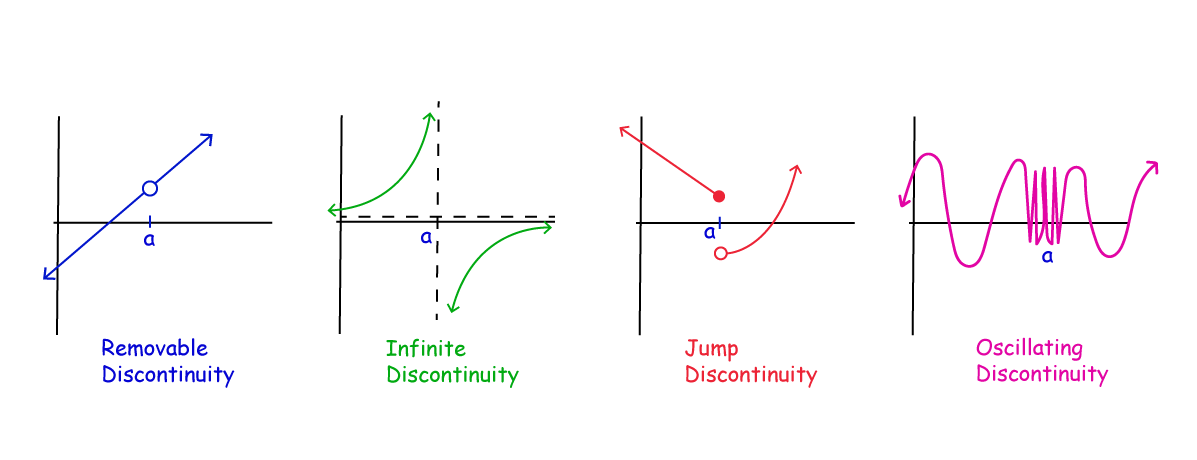
Fig. 26 4 common types of discontinuity#
Example
The indicator function \(x \mapsto \mathbb{1}\{x > 0\}\) has a jump discontinuity at \(0\).
Fact
Let \(f\) and \(g\) be functions and let \(\alpha \in \mathbb{R}\)
If \(f\) and \(g\) are continuous at \(x\) then so is \(f + g\), where
If \(f\) is continuous at \(x\) then so is \(\alpha f\), where
If \(f\) and \(g\) are continuous at \(x\) and real valued then so is \(f \circ g\), where
In the latter case, if in addition \(g(x) \ne 0\), then \(f/g\) is also continuous.
Proof
Just repeatedly apply the properties of the limits
Let’s just check that
Let \(f\) and \(g\) be continuous at \(x\)
Pick any \(x_n \to x\)
We claim that \(f(x_n) + g(x_n) \to f(x) + g(x)\)
By assumption, \(f(x_n) \to f(x)\) and \(g(x_n) \to g(x)\)
From this and the triangle inequality we get
As a result, set of continuous functions is “closed” under elementary arithmetic operations
Example
The function \(f \colon \mathbb{R} \to \mathbb{R}\) defined by
is continuous (we just have to be careful to ensure that denominator is not zero – which it is not for all \(x\in\mathbb{R}\))
Example
An example of oscillating discontinuity is the function \(f(x) = \sin(1/x)\) which is discontinuous at \(x=0\).
Example
Consider the mapping \(f : \mathbb{R} \rightarrow \mathbb{R}\) defined by \(f(x ) = x_2\). We want to show that \(f(x)\) is continuous at the point \(x = 2\).
Recall that \(d (x, y ) = \{ (y − x )2 \}^{\frac{1}{2}} = |y − x |\).
Note that \(|f (2) − f(x)| = |f(x) − f (2)| = |x^2 − 4| = |x − 2||x + 2|\).
Suppose that \(|2 − x | < \delta\). This means that \(|x − 2| < \delta\), which in turn means that \((2 − \delta) < x < (2 + \delta)\). Thus we have \((4 − \delta) < (x + 2) < (4 + \delta)\).
Let us restrict attention to \(\delta \in (0, 1)\). This gives us \(3 < (x + 2) < 5\), so that \(|x + 2| < 5\).
We have \(|f (2) − f(x)| = |f(x) − f (2)| = |x − 2||x + 2| < (\delta)(5) = 5\delta\).
We require \(|f (2) − f(x)| < \epsilon\). One way to ensure this is to set \(\delta = min(1, \frac{\epsilon}{5})\).
Example
Consider the mapping \(f: \mathbb{R} \rightarrow \mathbb{R}\) defined by \(f(x ) = x\). We want to show that \(f(x)\) is continuous for all \(x \in X\).
Recall that \(d (x, y ) = \{ (y − x )2 \}^{\frac{1}{2}} = |y − x |\).
Consider an arbitrary point \(x = a\). Note that \(|f (a) − f(x)| = |a − x |\).
Suppose that \(|a − x | < \delta\).
Note that if we set \(\delta = \epsilon\), we have \(|f (a) − f(x)| < \epsilon\).
Thus we know that \(f\) is continuous at the point \(x = a\). Since \(a\) was chosen arbitrarily, we now that this is true for all \(a \in \mathbb{R}\). This means that \(f\) is continuous for all \(x \in \mathbb{R}\).
Example
Consider the mapping \(f: \mathbb{R} \rightarrow \mathbb{R}\) defined by
We have already shown that \(\lim_{x \rightarrow 5} f(x)\) does not exist. This means that it is impossible for \(lim_{x \rightarrow 5} f(x) = f (5)\). As such, we know that \(f(x)\) is not continuous at the point \(x = 5\).
This means that f(x) is not a continuous function.
However, it can be shown that (i) \(f(x )\) is continuous on the interval \((−\infty, 5)\), and that (ii) \(f(x)\) is continuous on the interval \((5, \infty)\). Can you explain why this is the case?
Example
Consider the mapping \(f: \mathbb{R} \rightarrow \mathbb{R}\) defined by
This function is a rectangular hyperbola when \(x \ne 0\), but it takes on the value \(0\) when \(x = 0\). Recall that the rectangular hyperbola part of this function is not defined at the point \(x = 0\).
This function is discontinuous at the point \(x = 0\). Illustrate the graph of this function on the whiteboard.
Example
Consider the mapping \(f: \mathbb{R} \rightarrow \mathbb{R}\) defined by
This function is sometimes known as Dirichlet’s discontinuous function. It is discontinuous at every point in its domain.
Derivatives#
If it exists, the derivative of a function tells us the direction and magnitude of the change in the dependent variable that will be induced by a very small increase in the independent variable.
If it exists, the derivative of a function at a point is equal to the slope of the straight line that is tangent to the function at that point.
You should try and guess now what the derivative of a linear function of the form \(f(x) = ax + b\) will be.
Definition#
Consider a function \(f : X \rightarrow \mathbb{R}\), where \(X \subseteq \mathbb{R}\). Let \((x_0, f (x_0))\) and \((x_0 + h, f (x_0 + h))\) be two points that lie on the graph of this function.
Draw a straight line between these two points. The slope of this line is
What happens to this slope as \(h \rightarrow 0\) (that is, as the second point gets very close to the first point?
Definition
The (first) derivative of the function \(f(x)\) at the point \(x=x_{0}\), if it exists, is defined to be
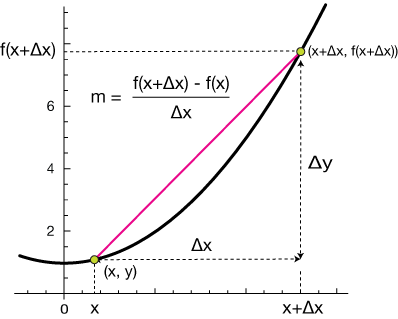
This is simply the slope of the straight line that is tangent to the function \(f(x)\) at the point \(x=x_{0}\).
We will now proceed to use this definition to find the derivative of some simple functions. This is sometimes called “finding the derivative of a function from first principles”.
Example: the derivative of a constant function
Consider the function \(f: X \longrightarrow \mathbb{R}\) defined by \(f(x)=b\), where \(b \in \mathbb{R}\) is a constant. Clearly we have \(f\left(x_{0}\right)=f\left(x_{0}+h\right)=b\) for all choices of \(x_{0}\) and \(h\).
Thus we have
for all choices of \(x_{0}\) and \(h\).
This means that
As such, we can conclude that
Example: the derivative of a linear function
Consider the function \(f: X \longrightarrow \mathbb{R}\) defined by \(f(x)=a x+b\). Note that
Thus we have
This means that \(\lim _{h \rightarrow 0} \frac{f\left(x_{0}+h\right)-f\left(x_{0}\right)}{h}=\lim _{h \rightarrow 0} a=a\).
As such, we can conclude that \(f^{\prime}(x)=\frac{d f}{d x}=a\).
Example: the derivative of a quadratic power function
Consider the function \(f: X \longrightarrow \mathbb{R}\) defined by \(f(x)=x^{2}\). Note that
Thus we have
This means that \(\lim _{h \rightarrow 0} \frac{f\left(x_{0}+h\right)-f\left(x_{0}\right)}{h}=\lim _{h \rightarrow 0}(2 x+h)=2 x\).
As such, we can conclude that \(f^{\prime}(x)=\frac{d f}{d x}=2 x\)
Example: the derivative of a quadratic polynomial function
Consider the function \(f: X \longrightarrow \mathbb{R}\) defined by \(f(x)=a x^{2}+b x+c\). Note that
Thus we have
This means that
As such, we can conclude that \(f^{\prime}(x)=\frac{d f}{d x}=2 a x+b\).
Fact (Binomial theorem)
The binomial theorem
Suppose that \(x, y \in \mathbb{R}\) and \(n \in \mathbb{Z}_+ = \mathbb{N} \cup \{0\}\).
We have
where \(\binom{n}{k} = C_{n,k} = \frac{n!}{k! (n − k)!}\) is known as a binomial coefficient (read “\(n\) choose \(k\)” because this is the number of ways to choose a subset of \(k\) elements from a set of \(n\) elements). \(n! = \prod_{k=1}^n k\) denotes a factorial of \(n\), and \(0! = 1\) by definition.
Useful property is \(\binom{n}{k} = C_{n,k} = C_{n-1,k-1}+C_{n-1,k}\) is illustrated by Pascal’s triangle.

Example: the derivative of a positive integer power function
Consider the function \(f: \mathbb{R} \longrightarrow \mathbb{R}\) defined by \(f(x)=x^{n}\), where \(n \in \mathbb{N}=\mathbb{Z}_{++}\). We know from the binomial theorem that
Thus we have
This means that
As such, we can conclude that
Example: derivative of an \(e^x\)
Consider the function \(f: \mathbb{R} \longrightarrow \mathbb{R}_{++}\) defined by \(f(x)=e^x\), where \(e\) in Euler’s constant. Recall that by definition \(e = \lim_{n \to \infty} (1+\frac{1}{n})^n\)
Consider \(\lim_{h \to 0}\frac{e^h-1}{h}\) after substitution \(t=(e^h-1)^{-1}\) \(\Leftrightarrow\) \(h = \ln(t^{-1}+1)\)
Therefore
Fact: The derivatives of some commonly encountered functions
If \(f(x)=a\), where \(a \in \mathbb{R}\) is a constant, then \(f^{\prime}(x)=0\).
If \(f(x)=a x+b\), then \(f^{\prime}(x)=a\).
If \(f(x)=a x^{2}+b x+c\), then \(f^{\prime}(x)=2 a x+b\).
If \(f(x)=x^{n}\), where \(n \in \mathbb{N}\), then \(f^{\prime}(x)=n x^{n-1}\).
If \(f(x)=\frac{1}{x^{n}}=x^{-n}\), where \(n \in \mathbb{N}\), then \(f^{\prime}(x)=-n x^{-n-1}=-n x^{-(n+1)}=\frac{-n}{x^{n+1}}\). (Note that we need to assume that \(x \neq 0\).)
If \(f(x)=e^{x}=\exp (x)\), then \(f^{\prime}(x)=e^{x}=\exp (x)\).
If \(f(x)=\ln (x)\), then \(f^{\prime}(x)=\frac{1}{x}\). (Recall that \(\ln (x)\) is only defined for \(x>0\), so we need to assume that \(x>0\) here.)
Some useful differentiation rules#
Fact: Scalar Multiplication Rule
If \(f(x)=c g(x)\) where \(c \in \mathbb{R}\) is a constant, then
Example
Let \(f(x) = a g(x)\) where \(g(x)=x\). From the derivation of the derivative of the linear functions we know that \(g'(x) = 1\) and \(f'(x) = a\). We can verify that \(f'(x) = a g'(x)\).
Fact: Summation Rule
If \(f(x)=g(x)+h(x)\), then
Example
Let \(f(x) = a x + b\) and \(g(x)=cx+d\). From the derivation of the derivative of the linear functions we know that \(f'(x) = a\) and \(g'(x) = c\). The sum \(f(x)+g(x) = (a+c)x+b+d\) is also a linear function, therefore \(\frac{d}{dx}\big(f(x)+g(x)\big) = a+c\).
We can thus verify that \(\frac{d}{dx}\big(f(x)+g(x)\big) = f'(x)+ g'(x)\).
Fact: Product Rule
If \(f(x)=g(x) h(x)\), then
Example
Let \(f(x) = x\) and \(g(x)=x\). From the derivation of the derivative of the linear functions we know that \(f'(x) = g'(x) = 1\). The product \(f(x)g(x) = x^2\) and from the derivation of above we know that \(\frac{d}{dx}\big(f(x)g(x)\big) = \frac{d}{dx}\big(x^2\big) = 2x\).
Using the product formula we can verify \(\frac{d}{dx}\big(f(x)g(x)\big) = 1\cdot x + x \cdot 1 = 2x\).
Fact: Quotient Rule
If \(f(x)=\frac{g(x)}{h(x)}\), then
The quotient rule is redundant#
In a sense, the quotient rule is redundant. The reason for this is that it can be obtained from a combination of the product rule and the chain rule.
Suppose that \(f(x)=\frac{g(x)}{h(x)}\). Note that
Let \([h(x)]^{-1}=k(x)\). We know from the chain rule that
Note that
We know from the product rule that
This is simply the quotient rule!
Fact: Chain Rule
If \(f(x)=g(h(x))\), then
Example: the derivative of an exponential function
Suppose that \(f(x)=a^{x}\), where \(a \in \mathbb{R}_{++}=(0, \infty)\) and \(x \neq 0\).
We can write \(f(x) = e^{\ln a^{x}} = e^ {x \ln(a)}\), and using the chain rule
Fact: The Inverse Function Rule
Suppose that the function \(y=f(x)\) has a well defined inverse function \(x=f^{-1}(y)\). If appropriate regularity conditions hold, then
Example: the derivative of a logarithmic function
Suppose that \(f(x)=\log _{a}(x)\), where \(a \in \mathbb{R}_{++}=(0, \infty)\) and \(x>0\).
Recall that \(y = \log _{a}(x) \iff a^y = x\). Then evaluating \(\frac{dx}{dy}\) using the derivative of the exponential function we have
On the other hand, using the inverse function rule we have
Combining the two expressions and reinserting \(a^y = x\), we have
Example: product rule
Consider the function \(f(x)=(a x+b)(c x+d)\).
Differentiation Approach One: Note that
Thus we have
Differentiation Approach Two: Note that \(f(x)=g(x) h(x)\) where \(g(x)=a x+b\) and \(h(x)=c x+d\). This means that \(g^{\prime}(x)=a\) and \(g^{\prime}(x)=c\). Thus we know, from the product rule, that
Differentiability and continuity#
Continuity is a necessary, but not sufficient, condition for differentiability.
Being a necessary condition means that “not continuous” implies “not differentiable”, which means that differentiable implies continuous.
Not being a sufficient condition means that continuous does NOT imply differentiable.
Differentiability is a sufficient, but not necessary, condition for continuity.
Being a sufficient condition means that differentiable implies continuous.
Not being a necessary condition means that “not differentiable” does NOT imply “not continuous”, which means that continuous does NOT imply differentiable.
Continuity does NOT imply differentiability#
To support this statement all we need is to demonstrate a single example of a function that is continuous at a point but not differentiable at that point.
Proof
Consider the function
(There is no problem with this double definition at the point \(x=1\) because the two parts of the function are equal at that point.)
This function is continuous at \(x=1\) because
and
However, this function is not differentiable at \(x=1\). To show this it is convenient to use the Heine definition of the limit for a function in application to the derivative.
Consider two sequence converging to \(x=1\) from two different directions:
Then at \(x=1\)
but
Thus, for two different convergent sequences \(p_n\) and \(q_n\) we have two different limits of the derivative at \(x=1\). We conclude that the limit \(\lim _{h \rightarrow 1} \frac{f(1+h)-f(1)}{h}\) is undefined.
\(\blacksquare\)
Example
A example of a function that is continuous at every point but not differentiable at any point is the Wiener process (Brownian motion).
Differentiability implies continuity#
Proof
Consider a function \(f: X \longrightarrow \mathbb{R}\) where \(X \subseteq \mathbb{R}\). Suppose that
exists.
We want to show that this implies that \(f(x)\) is continuous at the point \(a \in X\). The following proof of this proposition is drawn from [Ayres Jr and Mendelson, 2013] (Chapter 8, Solved Problem 2).
First, note that
Thus we have
Now note that
Upon combining these two results, we obtain
Finally, note that
Thus we have
This means that \(f(x)\) is continuous at the point \(x=a\).
\(\blacksquare\)
Higher-order derivatives#
Suppose that \(f: X \longrightarrow \mathbb{R}\), where \(X \subseteq \mathbb{R}\), is an \(n\)-times continuously differentiable function for some \(n \geqslant 2\).
We can view the first derivative of this function as a function in its own right. This can be seen by letting \(g(x)=f^{\prime}(x)\).
The second derivative of \(f(x)\) with respect to \(x\) twice is simply the first derivative of \(g(x)\) with respect to \(x\).
In other words,
or, if you prefer,
Thus we have
The same approach can be used for defining third and higher order derivative.
Definition
The \(n\)-th order derivative of a function \(f \colon \mathbb{R} \to \mathbb{R}\), if it exists, is the derivative of it’s \((n-1)\)-th order derivative treated as an independent function.
for all \(k \in\{1,2, \cdots, n\}\), where we define
Example
Let \(f(x)=x^{n}\)
Then we have:
\(f^{\prime}(x)=\frac{d f(x)}{d x}=n x^{n-1}\)
\(f^{\prime \prime}(x)=\frac{d f^{\prime}(x)}{d x}=n(n-1) x^{n-2}\),
\(f^{\prime \prime \prime}(x)=\frac{d f^{\prime \prime}(x)}{d x}=n(n-1)(n-2) x^{n-3}\),
and so on and so forth until
\(f^{(k)}(x)=\frac{d f^{(k-1)}(x)}{d x}=n(n-1)(n-2) \cdots(n-(k-1)) x^{n-k}\),
and so on and so forth until
\(f^{(n)}(x)=\frac{d f^{(n-1)}(x)}{d x}=n(n-1)(n-2) \cdots(1) x^{0}\).
Note that \(n(n-1)(n-2) \cdots(1)=n\) ! and \(x^{0}=1\) (asuming that \(x \neq 0\) ).
This means that \(f^{(n)}(x)=n\) !, which is a constant.
As such, we know that \(f^{(n+1)}(x)=\frac{d f^{(n)}(x)}{d x}=0\).
This means that \(f^{(n+j)}(x)=0\) for all \(j \in \mathbb{N}\).
Taylor series#
Definition
The function \(f: X \to \mathbb{R}\) is said to be of differentiability class \(C^m\) if derivatives \(f'\), \(f''\), \(\dots\), \(f^{(m)}\) exist and are continuous on \(X\)
Fact
Consider \(f: X \to \mathbb{R}\) and let \(f\) to be a \(C^m\) function. Assume also that \(f^{(m+1)}\) exists, although may not necessarily be continuous.
For any \(x,a \in X\) there is such \(z\) between \(a\) and \(x\) that
where the remainder is given by
Definition
Little-o notation is used to describe functions that approach zero faster than a given function
Loosely speaking, if \(f \colon \mathbb{R} \to \mathbb{R}\) is suitably differentiable at \(a\), then
for \(x\) very close to \(a\),
on a slightly wider interval, etc.
These are the 1st and 2nd order Taylor series approximations to \(f\) at \(a\) respectively
As the order goes higher we get better approximation

Fig. 27 4th order Taylor series for \(f(x) = \sin(x)/x\) at 0#
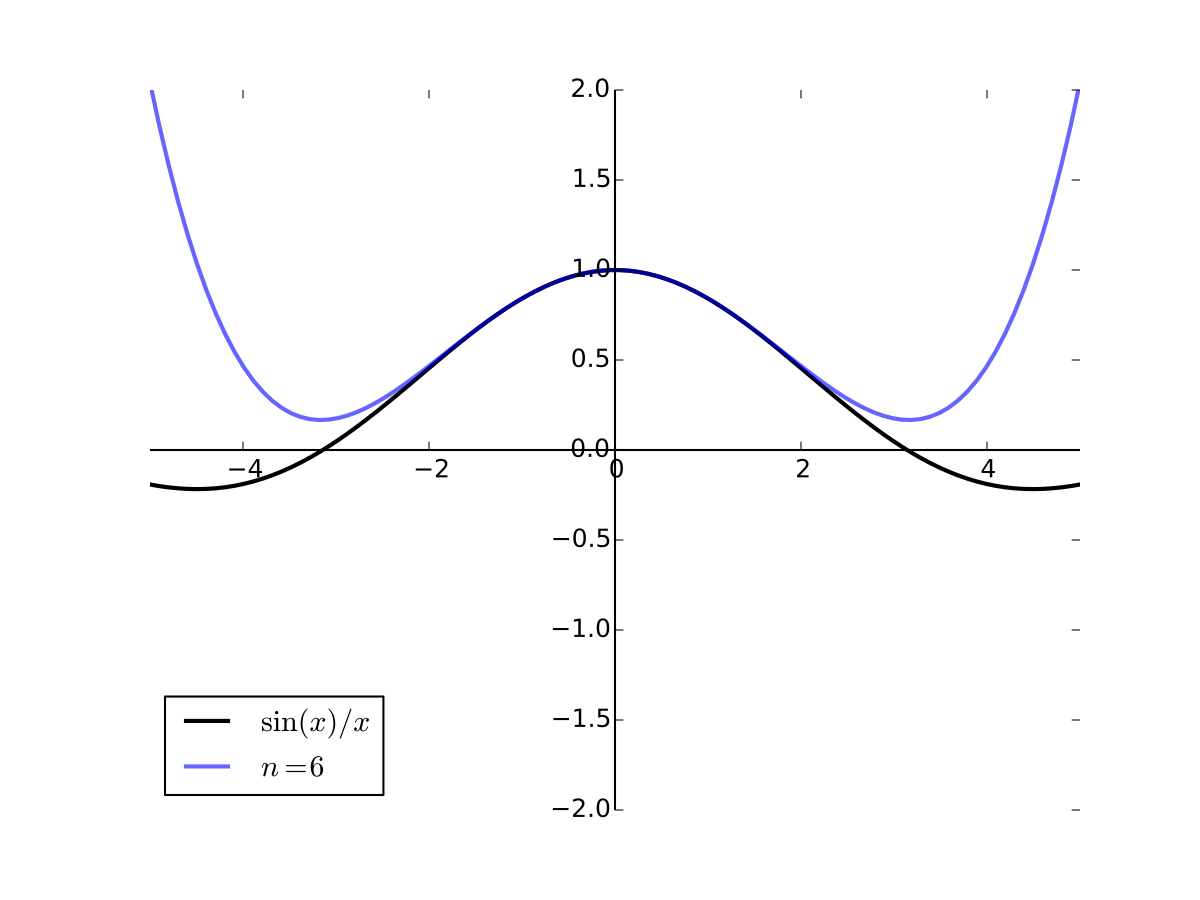
Fig. 28 6th order Taylor series for \(f(x) = \sin(x)/x\) at 0#

Fig. 29 8th order Taylor series for \(f(x) = \sin(x)/x\) at 0#
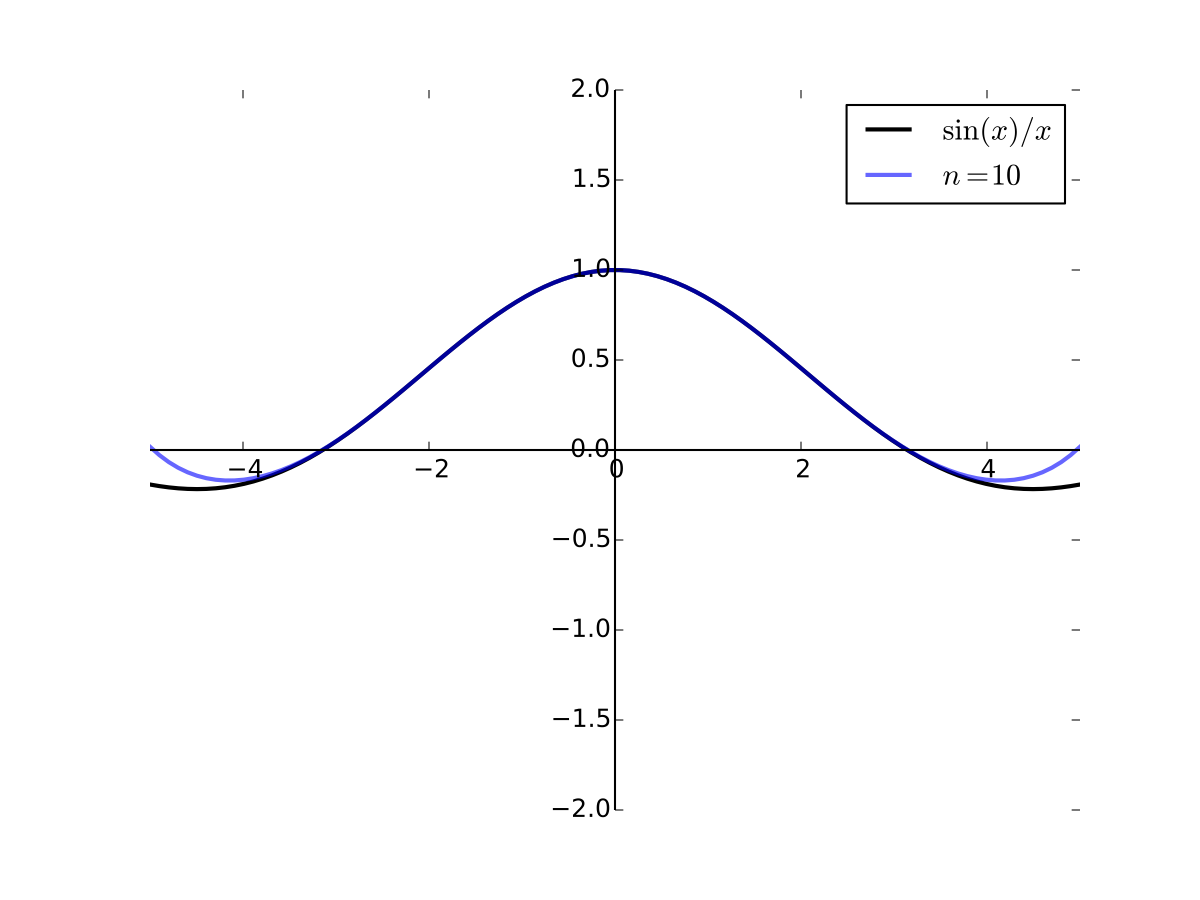
Fig. 30 10th order Taylor series for \(f(x) = \sin(x)/x\) at 0#
L’Hopital’s rule#
Consider the function \(f(x)=\frac{g(x)}{h(x)}\).
Definition
If \(\lim _{x \rightarrow x_{0}} g(x)=\lim _{x \rightarrow x_{0}} h(x)=0\), we call this situation an “\(\frac{0}{0}\)” indeterminate form
If \(\lim _{x \rightarrow x_{0}} g(x)= \pm \infty\), \(\lim _{x \rightarrow x_{0}} h(x)= \pm \infty\), we call this situation an “\(\frac{ \pm \infty}{ \pm \infty}\)” indeterminate form
Fact: L’Hopital’s rule for limits of indeterminate form
Suppose that \(g(x)\) and \(h(x)\) are both differentiable at all points on a non-empty interval \((a, b)\) that contains the point \(x=x_{0}\), with the possible exception that they might not be differentiable at the point \(x_{0}\).
Suppose also that \(h^{\prime}(x) \neq 0\) for all \(x \in(a, b)\).
Further, assume that for \(f(x)=\frac{g(x)}{h(x)}\) we have either “\(\frac{0}{0}\)” or “\(\frac{ \pm \infty}{ \pm \infty}\)” indeterminate form.
Then if \(\lim _{x \rightarrow x_{0}}\frac{g^{\prime}(x)}{h^{\prime}(x)}\) exists, then
all four conditions have to hold for the L’Hopital’s rule to hold!
Example
Note that in the examples below we have “\(\frac{0}{0}\)” indeterminacy, and both enumerator and denominator functions are differentiable around \(x=0\)
Example
L’Hopital’s rule is not applicable for \(\lim_{x \to 0} \frac{x}{\ln(x)}\) because neither “\(\frac{0}{0}\)” nor “\(\frac{ \pm \infty}{ \pm \infty}\)” indeterminacy form applies.
Some economic applications of derivatives#
Marginal revenue and marginal cost#
If a firm’s total revenue as a function of output is given by the function \(R(Q)\), then its marginal revenue is given by the first derivative of that function:
If a firm’s total cost as a function of output is given by the function \(C(Q)\), then its marginal cost is given by the first derivative of that function:
Interpretation of marginal values: change (in \(R\) of \(C\)) caused by a small (infinitesimal) change in the variable \(Q\).
Often interpreted as a changed caused by the unit change in the variable, using linear Taylor approximation.
Marginal revenue for a monopolist#
Consider a single-priced monopolist that faces an inverse demand curve that is given by the function \(P(Q)\). Since demand curves usually slope down, we will assume that \(P^{\prime}(Q)<0\). The total revenue for this monopolist is given by \(R(Q)=P(Q) Q\). As such, the marginal revenue for this monopolist is
Since \(P(Q)\) will be the market price when the monopolist produces \(Q>0\) units of output and \(P^{\prime}(Q)<0\), we know that marginal revenue is less than the market price for a monopolist.
The two terms that make up marginal revenue for a monopolist can be given a very intuitive explanation. If the monopolist increases its output by a small amount, it receives the market price for the additional output (hence the \(P(Q)\) term), but it loses some revenue due to the lower price that it will receive for all of the pre-existing output (the \(P^{\prime}(Q) Q\) term).
Point elasticities#
Definition (in words)
Suppose that \(y=f(x)\). The elasticity of \(y\) with respect to \(x\) is defined to be the percentage change in \(y\) that is induced by a small (infinitesimal) percentage change in \(x\).
So, what is a percentage change in \(x\)?
\(x\) to \(x+h\), making \(h\) the absolute change in \(x\)
\(x\) to \(x + rx\), making \((x+rx)/x = 1+r\) the relative change in \(x\), and \(r\) is the relative change rate
percentage change in \(x\) is the relative change rate expressed in percentage points
We are interested in infinitesimal percentage change, therefore in the limit as \(r \to 0\) (irrespective of the units of \(r\))
What is the percentage change in \(y\)?
Answer: rate of change of \(f(x)\) that can be expressed as
Let’s consider the limit
Define a new function \(g\) such that \(f(x) = g\big(\ln(x)\big)\) and \(f\big(x(1+r)\big) = g\big(\ln(x) + \ln(1+r)\big)\)
Continuing the above, and noting that \(\ln(1+r) \to 0\) as \(r \to 0\) we have
See the example above showing that \(\lim_{r \to 0} \frac{\ln(1+r)}{r} = 1\).
In the last step, to make sense of the expression \(\frac{d f(x)}{d \ln(x)}\), imagine that \(x\) is a function of some other variable we call \(\ln(x)\). Then we can use the chain rule and the inverse function rule to show that
Note, in addition, that by the chain rule the following also holds
Putting everything together, we arrive at the following equivalent expressions for elasticity.
Definition (exact)
The (point) elasticity of \(f(x)\) with respect to \(x\) is defined to be the percentage change in \(y\) that is induced by a small (infinitesimal) percentage change in \(x\), and is given by
Example
Suppose that we have a linear demand curve of the form
where \(a > 0\) and \(b > 0\) The slope of this demand curve is equal to \((−b)\) As such, the point own-price elasticity of demand in this case is given by
Note that
More generally, we can show that, for the linear demand curve above, we have
Since the demand curve above is downward sloping, this means that
Example
Suppose that we have a demand curve of the form
where \(a > 0\). Computing the point elasticity of demand at price \(P\) we have
Constant own-price elasticity!
Alternatively we could compute this elasticity as
Notes from the lecture#
Further reading and self-learning
Great video on Taylor series YouTube Morphocular
